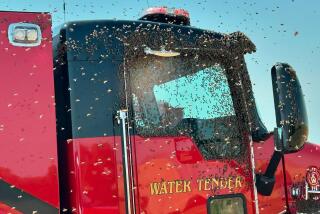Killer bee season underway with a vengeance
Summer’s here, bringing climbing temperatures, rising humidity in some areas and the renewed threat from killer bees.
So far this season a colony of 100,000 Africanized honeybees have taken up residence in a Houston home and a similar sized swarm attacked two park workers in Florida. At least one death has been reported in Central Texas as well as attacks on humans and animals elsewhere.
“It’s nearly impossible to put a number on the deaths,” Kim Kaplan, speaking for the Agricultural Research Service of the U.S. Department of Agriculture said on Wednesday. “It is minuscule. The Centers for Disease Control doesn’t find enough to even make a separate category” for killer-bee-related deaths.
Still, a very minor level of danger doesn’t mean there is no danger at all.
In recent years the areas where killer bees have been spotted have been increasing, and parts of the Southern and Southwestern states have reported incursions.
First-tier states like California and Texas have reported incursions, as have some second-tier states like Oklahoma and Nevada. No states in the third tier -- those that lay north of the first two tiers -- have reported any incursions, said Kaplan, who has been handling killer bee issues since before the first identification in the United States in 1990.
The killer bee phenomenon began with an accidental release of Africanized queen bees in 1957 in Brazil. The Africanized bees had been brought to South America to breed a bee by crossing them with local bees. The idea was to create a bee that was more tolerant of hot conditions and would produce more honey.
Once the African bees got into the wild, they began to mate and spread north. Among their less desirable traits, Kaplan said, is that Africanized bees are more defensive of their hives and quicker to swarm than the Western honeybee known in most of the country. A mild provocation is more likely to be met with a more violent response because they can attack in greater numbers and pursue potential victims for a longer distance.
The venom in killer bees is no stronger than what is found in the Western honeybee species, making it difficult even for experts to identify which variety of bees is the culprit in any incident. For someone allergic to bees, the sting from either one is equally harmful. For non-allergic people, the greater number of stings from a swarm of killer bees is more dangerous than the stings of a few Western bees.
Some people have tied the growth of the killer bees to climate-change factors, but Kaplan said the issue seems to be more complicated. Killer bees had been expected to reach the United States in the 1980s, but it took a decade longer for them to arrive because of drought conditions south of the U.S. border, she said.
“It’s not just temperature,” Kaplan said. “It’s humidity, rain and temperature. We don’t know for sure, but it seems to be some combination of temperature, humidity and rainfall is needed for their spread.”
If the cause of the spread of the killer bees is still a bit up in the air, the recommendation of how to deal with them in very much on the ground: run.
People should run, as fast and as far as they can, and they can usually out distance the killer bees, which are limited to about a quarter of a mile from their hives. Those using heavy equipment in key areas, like Texas, should walk their property looking for bee infestations before using heavy machinery, whose low frequency vibrations are felt by the killer bees as an attack, Kaplan said.
ALSO:
Ariel Castro’s house of horror demolished in Cleveland
Death of obese Ohio inmate escalates death penalty debate
‘Whitey’ Bulger jury seeks clarification on aiding and abetting
Follow L.A. Times National on Twitter
More to Read
Sign up for Essential California
The most important California stories and recommendations in your inbox every morning.
You may occasionally receive promotional content from the Los Angeles Times.











